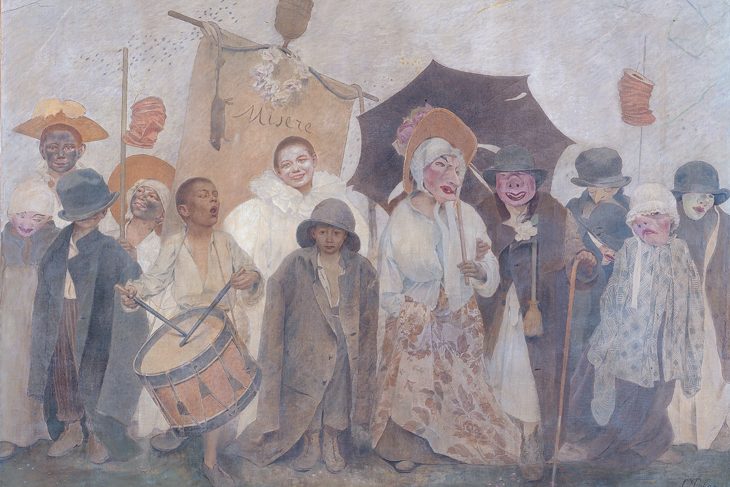This volume is an honest, moving but mildly unsatisfying farewell by Linda Nochlin (1931– 2017), one of the great figures in the social history of art. Her survey of realism, first published by Penguin in 1971, remains unsurpassed and her essays on women artists, the gendered gaze, and orientalism are seminal contributions. Following her death last year, tributes flooded in for an inspirational teacher and champion of female scholars within the academy. If this is Nochlin’s last publication, it is a shame that Thames & Hudson has not seized the opportunity to include a preface paying tribute to her gifts and achievements.
This is a brilliant and important topic, but this volume gives only a preparatory sketch of how it might be treated. The five short chapters, some of which have already been published, are culled from different places. They include a lecture on Géricault and Goya delivered at the Prado in 2012, and an essay on Courbet and beggars from the exhibition catalogue for ‘Courbet: A Dream of Modern Art’. While it is good to have these pieces translated and reunited, the chapters pull in different directions, marring the unity of the book.
Rue des Moulins (1894), Henri de Toulouse-Lautrec. Courtesy National Gallery of Art, Washington D.C.
The first chapter concerns the visual culture of famine in Ireland, the nation which Buret described as ‘the privileged domain of misery’. Nochlin highlights the relative scarcity of representations of the suffering produced by the famine – aside from powerful canvases such as Daniel MacDonald’s An Irish Peasant Family Discovering the Blight of their Store – and the persistence of gendered, Marian types within those representations. This is compelling but hardly original, and Nochlin cites at length from other scholars who have published on this topic. The second chapter on the representation of prostitution also covers familiar ground, questioning the gendered assumptions at play within Toulouse-Lautrec and Degas’ depictions of brothel life (including the absence of men afflicted with venereal disease). The main purpose of the chapter seems to be a polemic against the curators of the ‘Splendeurs et Misères’ exhibition at the Musée d’Orsay in 2015. By dissolving sexuality into a ‘neutral’ branch of social history, the show was guilty of ‘allowing or encouraging the museum-going public, its male half particularly, a gratifying wallow in erotica’, with titillation dressed up as education.
These asides are revealing of Nochlin’s politics and priorities, but render the opening chapters ruminative rather than scholarly. This flow of associations is compounded by the broad chronological range of allusions. The Irish chapter closes with a meditation on the efficacy of the different famine memorials in Ireland and New York; the analysis of Géricault vaults ahead to Lewis Hine, Dorothea Lange, and a disagreement with Martha Rosler’s pronouncement on depicting the Bowery in the 1970s. Yet while invoking the shape of a grand ‘documentary’ aesthetic, Nochlin’s finest passages reflect her attention to specific compositions. Although Géricault’s debt to English prints is well-known, Nochlin draws out how the cumulative detail in Géricault’s London lithographs – the crumpled hat, the brickwork pattern, the grainy wood, the peeling poster, the dog’s paw – endow these figures with a haunting pathos and solemnity.
The Piper (from Various Subjects Drawn from Life and on Stone; The English Set) (1821), Théodore Géricault. © The Trustees of the British Museum, London
The closing chapters allow Nochlin to return to one of her favourite painters – Courbet – and introduce a far-less studied but fascinating artist, Fernand Pelez. Nochlin makes a case for the persistence of the theme of beggars within the Courbet corpus, from the striking Vagabond from the 1840s to the plight of village women in the snow and the monumental Charity of a Beggar at Ornans (1868) in the Burrell collection. In its deliberate crudity also lies the painting’s humanity: ‘a call for justice in broad daylight, both unequivocal and unappealing’. Nochlin laments that such stark and simple visions got lost in the work of the modernists (with beggars ironised by Manet or substituted for sunshine by Van Gogh) and have fallen out of art-historical scholarship. A truer heir for Courbet seems to be Pelez, whose fin-de-siècle depiction of homeless urchins, sad circus entertainers, or destitute old men queuing for bread, are a revelation. In imagining a non-modernist lineage for a socially committed, documentary type of art, Nochlin echoes the recent rehabilitation of naturalism by Gabriel Weisberg. His work has shown how Pelez’s approach can be fruitfully compared with painters like Jules Bastien-Lepage, Léon Frédéric or Émile Friant.
Charity of a Beggar at Ornans (1868), Gustave Courbet. © CSG CIC Glasgow Museums Collection
New research is needed on modern art’s relationship to indigence. The confrontation with la misère inspired many 19th-century artists to experiment with imperfection, refusing ‘conventional beauty or elegance’. In this slightly uneven set of essays, Nochlin has raised incisive and uncomfortable questions about the politics of representation that other scholars will need to answer and substantiate. In this way she was a trailblazer to the end.
Misère: The Visual Representation of Misery in the 19th Century by Linda Nochlin is published by Thames & Hudson.
From the April issue of Apollo. Preview and subscribe here.
